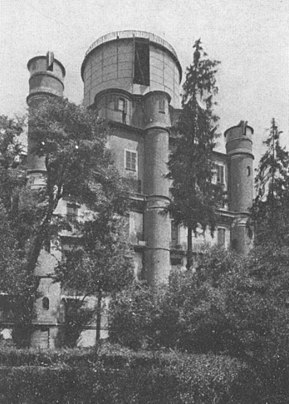
Back مرصد بريرا الفلكي Arabic مرصد بريرا الفلكى ARZ Osservatorio Astronomico di Brera German Observatorio Astronómico de Brera Spanish Observatoire astronomique de Brera French Բրերա աստղադիտարան Armenian Osservatorio astronomico di Brera Italian Astronomeschen Observatoire vu Brera LB Osservatòri astronòmich de Brera LMO Osservatòri astronòmich ëd Brera PMS
 (ca. 1886-1890) | |
| Alternative names | osservatorio astronomico di Brera |
|---|---|
| Observatory code | 027 |
| Location | Brera district of Milan, Italy |
| Coordinates | 45°28′19″N 9°11′16″E / 45.47199°N 9.1877°E |
| Website | http://www.brera.inaf.it,%20http://www.brera.unimi.it |
| Telescopes | |
| | |
The Brera Observatory (Italian: Osservatorio Astronomico di Brera) is an astronomical observatory in the Brera district of Milan, Italy. It was built in the historic Palazzo Brera in 1764 by the Jesuit astronomer Roger Boscovich.[1] Following the suppression of the Jesuits by Clement XIV on 21 July 1773, the palace and the observatory passed to the then rulers of northern Italy, the Austrian Habsburg dynasty.[2]
From 1 December 1786, the Austrian Empire adopted “transalpine time”. The astronomers were engaged by Count Giuseppe Di Wilczek, the plenipotentiary governor of Lombardy, to build a meridian line inside Milan Cathedral.[3] It was constructed by Giovanni Angelo Cesaris and Francesco Reggio, with Roger Joseph Boscovich acting as a consultant.
Following the incorporation of Milan into the Kingdom of Italy in 1861, the observatory has been run by the Italian government.

In 1862, the newly installed Italian government improved the observatory's facilities by commissioning a 218mm Merz Equatorial Refracting Telescope to the German constructor Georg Merz.[4][5] In 1946 the observatory became part of the scientific institutions of the new born Italian Republic and since 2001 it has become part of the National Institute of Astrophysics (INAF).
Astronomer Margherita Hack worked at the Observatory from 1954 to 1964, until she became Professor of the Institute of Physics at the Trieste University.
Today the Observatory's staff consists of approximatively one hundred people. The research area covers a large range of fields from planets to stars, black holes, galaxies, gamma-ray bursts and cosmology. The Observatory is also active in the technological research applied to the astronomical instrumentation and it is one of the world leaders in the development of X-ray astronomy optics and light instrumentation for space missions.[6]
- ^ Cite error: The named reference
mariowas invoked but never defined (see the help page). - ^ Cite error: The named reference
treccwas invoked but never defined (see the help page). - ^ Heilbron, John Lewis (1990). The Sun in the Church. Cathedrals as Solar Observatories. Harvard University Press. p. 268. ISBN 0674005368.
- ^ http://www.brera.unimi.it/index.php?option=com_content&view=article&id=75&Itemid=137&lang=en Archived 2014-12-22 at the Wayback Machine Brera Astronomical Observatory, refracting telescope that was ordered to the German constructor Georg Merz (1793-1867).
- ^ Bernagozzi, Andrea; Testa, Antonella; Tucci, Pasquale (2004). "Observing Mars with Schiaparelli's telescope". Third European Workshop on Exo-Astrobiology. 545: 157. Bibcode:2004ESASP.545..157B. In 1862, The Government of Italy funded the purchase of a 218mm Merz Equatorial Refracting Telescope for the Brera Astronomical Observatory
- ^ "INAF - OA-Brera".
© MMXXIII Rich X Search. We shall prevail. All rights reserved. Rich X Search
